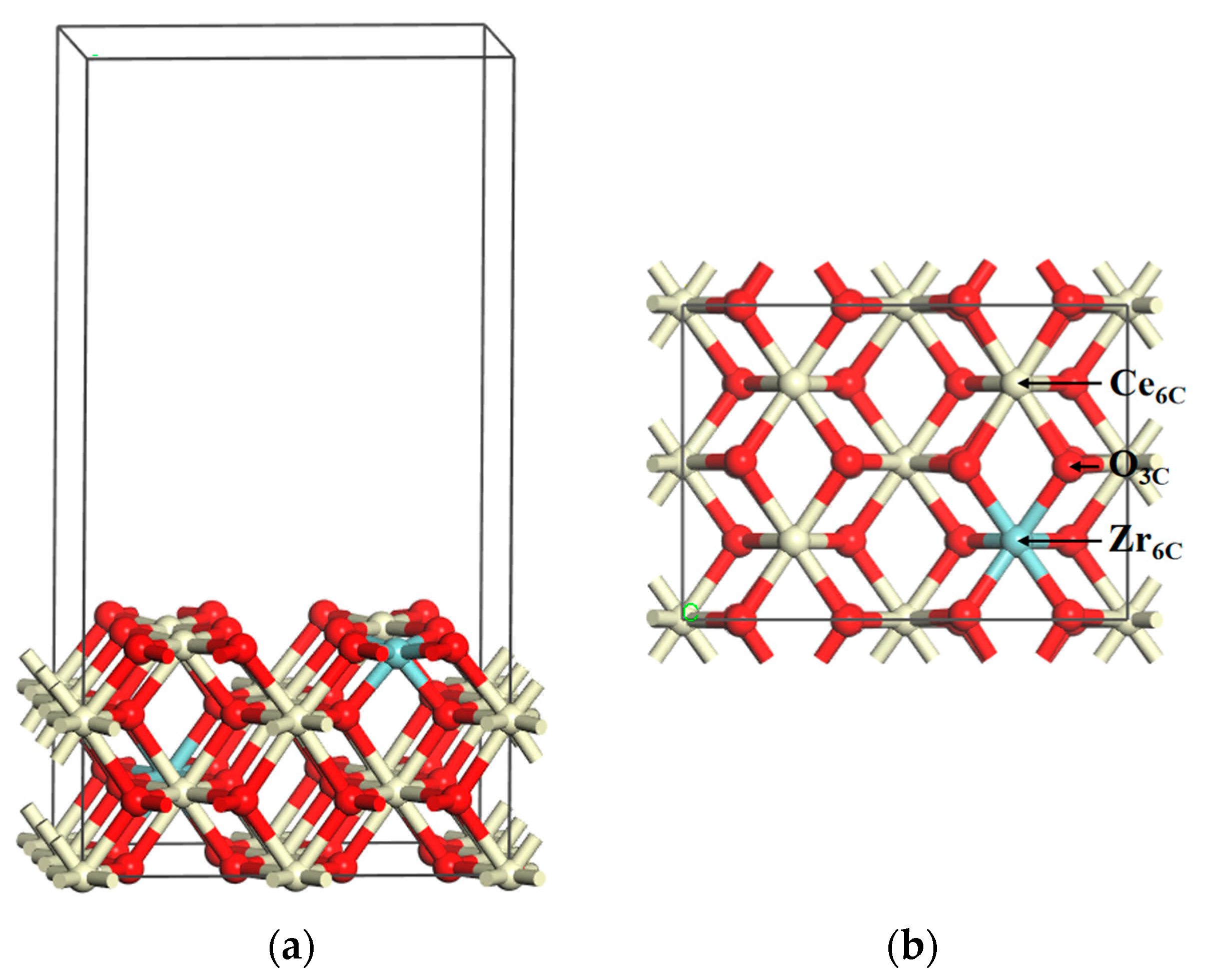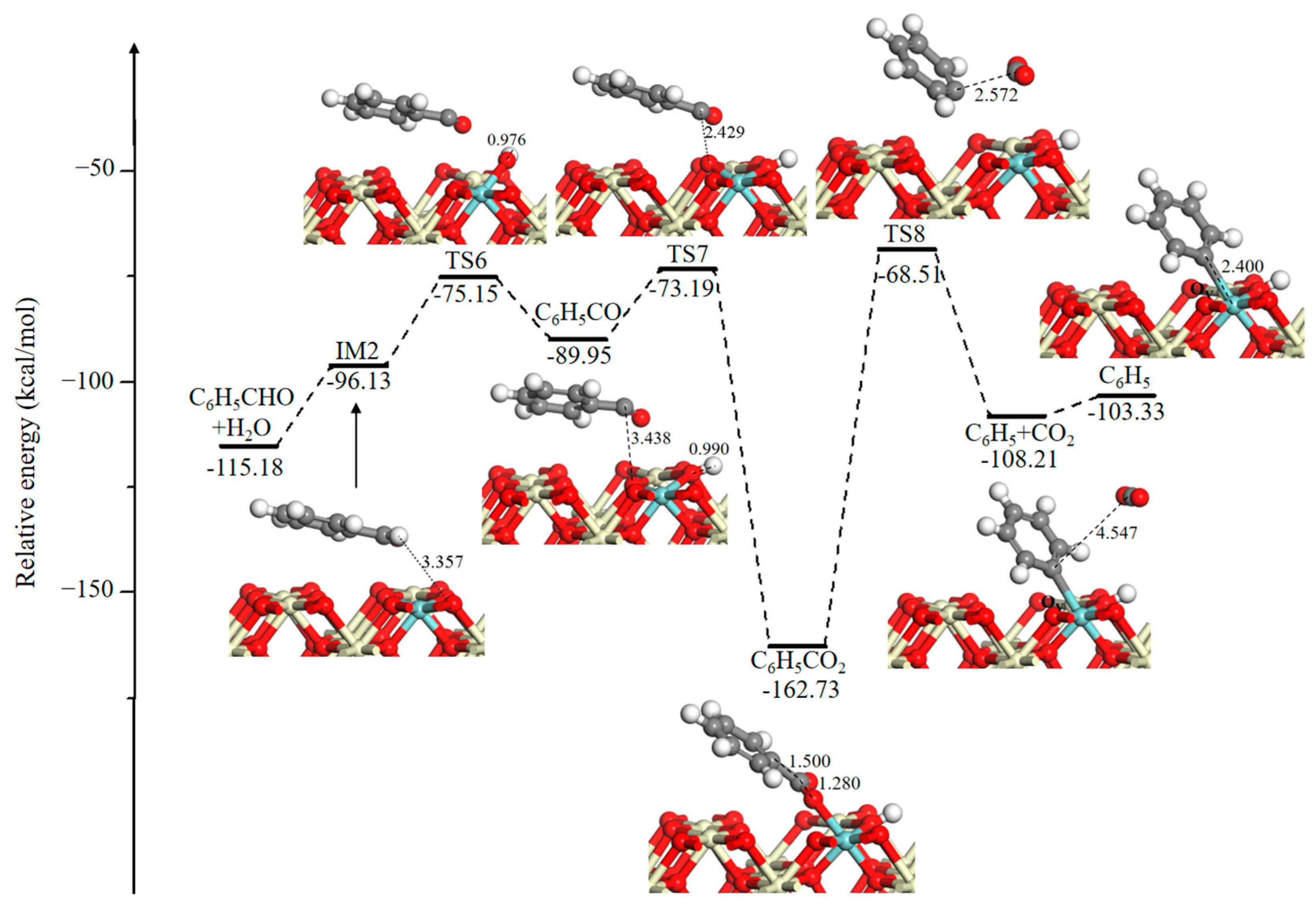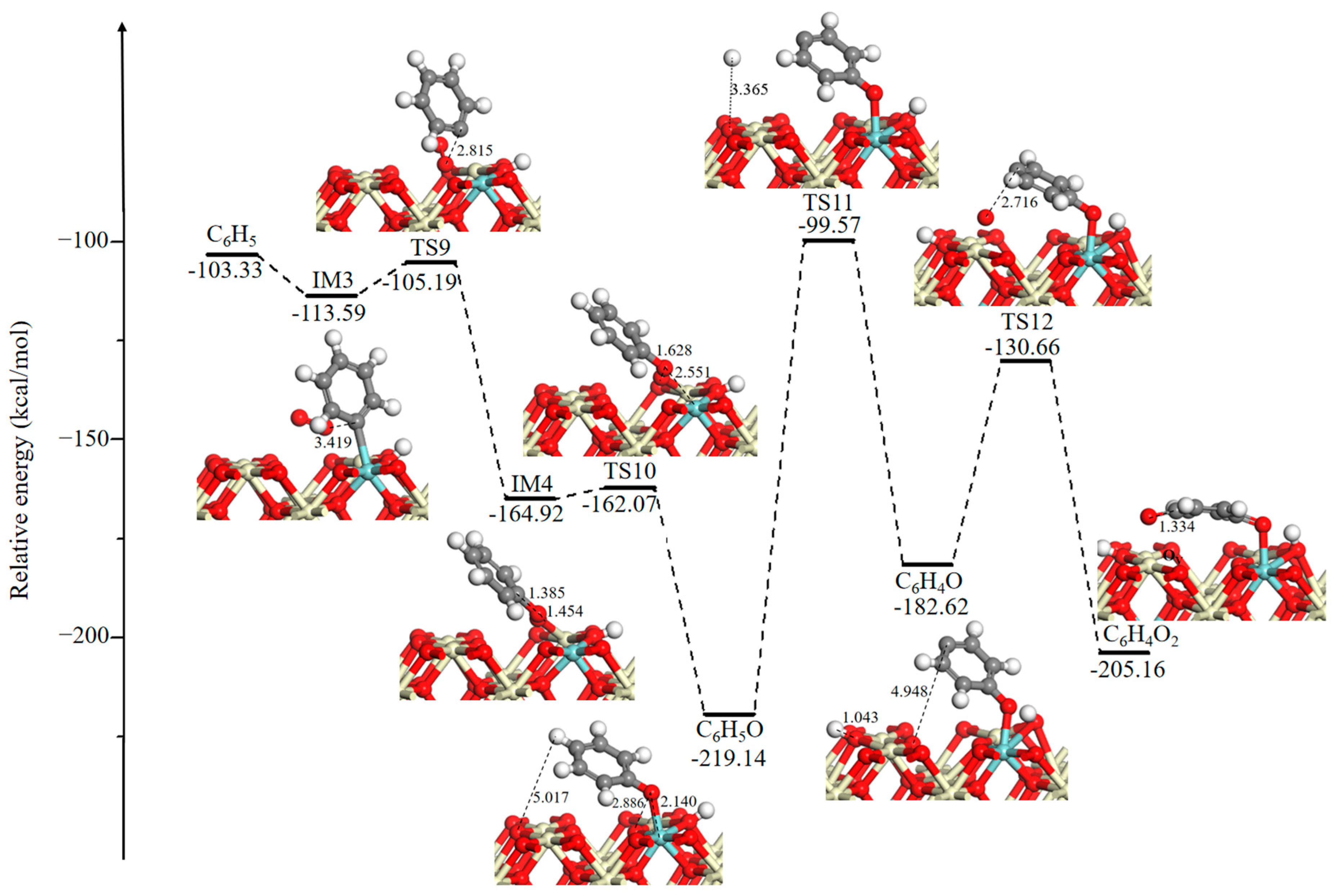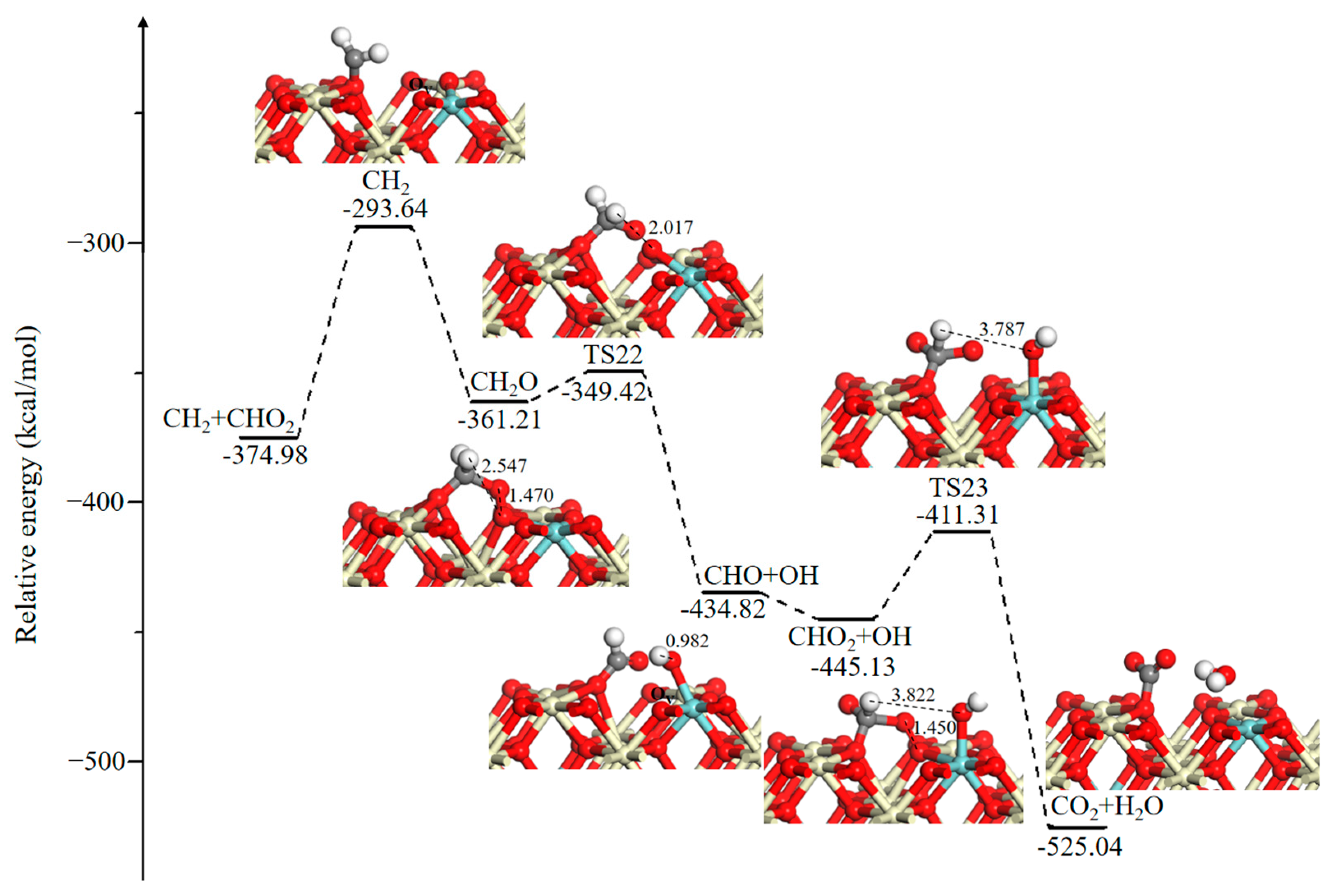Catalytic Oxidation Mechanism of Toluene on the Ce0.875Zr0.125O2 (110) Surface
Abstract
:1. Introduction
2. Results and Discussion
2.1. Tests of Computational Conditions
2.2. Reaction Mechanism of Toluene Total Oxidation over the Ce0.875Zr0.125O2 (110) Surface
2.2.1. Pathway for Methyl Group Oxidation
2.2.2. Pathway for Ring-Opening Reaction
2.2.3. Pathway for Oxidation of Small Molecule Intermediates
2.3. Electronic Structures
3. Computational Methods and Parameter Settings
4. Conclusions
Supplementary Materials
Author Contributions
Funding
Data Availability Statement
Conflicts of Interest
References
- Amann, M.; Lutz, M. The revision of the air quality legislation in the European Union related to ground-level ozone. J. Hazard. Mater. 2000, 78, 41–62. [Google Scholar] [CrossRef] [PubMed]
- Riipinen, I.; Yli-Juuti, T.; Pierce, J.R.; Petäjä, T.; Worsnop, D.R.; Kulmala, M.; Donahue, N.M. The contribution of organics to atmospheric nanoparticle growth. Nat. Geosci. 2012, 5, 453–458. [Google Scholar] [CrossRef]
- He, C.; Cheng, J.; Zhang, X.; Douthwaite, M.; Pattisson, S.; Hao, Z. Recent advances in the catalytic oxidation of volatile organic compounds: A review based on pollutant sorts and sources. Chem. Rev. 2019, 119, 4471–4568. [Google Scholar] [CrossRef] [PubMed]
- Derwent, R.G.; Jenkin, M.E.; Saunders, S.M. Photochemical ozone creation potentials for a large number of reactive hydrocarbons under European conditions. Atmos. Environ. 1996, 30, 181–199. [Google Scholar] [CrossRef]
- Derwent, R.G.; Jenkin, M.E.; Saunders, S.M.; Pilling, M.J. Photochemical ozone creation potentials for organic compounds in northwest Europe calculated with a master chemical mechanism. Atmos. Environ. 1998, 32, 2429–2441. [Google Scholar] [CrossRef]
- Xie, Z.H.; Zhong, J.P.; Tian, J.T.; Liu, P.; Ren, Q.M.; Chen, L.M.; Fu, M.L.; Ye, D.Q. Unraveling the role of OH groups over CeO2 derived from methanol modification for enhancing toluene oxidation: Experimental and theoretical studies. Appl. Catal. A Gen 2023, 654, 119069. [Google Scholar] [CrossRef]
- Das, D.; Gaur, V.; Verma, N. Removal of volatile organic compound by activated carbon fiber. Carbon 2004, 42, 2949–2962. [Google Scholar] [CrossRef]
- Shi, Q.; Kang, D.; Wang, Y.; Zhang, X. Emission control of toluene in iron ore sintering using catalytic oxidation technology: A critical review. Catalysts 2023, 13, 429. [Google Scholar] [CrossRef]
- Ye, L.M.; Lu, P.; Yan, X.H.; Huang, H.B. Boosting simultaneous catalytic removal of NOx and toluene via cooperation of Lewis acid and oxygen vacancies. Appl. Catal. B Environ. 2023, 331, 122696. [Google Scholar] [CrossRef]
- Bhaskaran, A.; Sharma, D.; Roy, S.; Singh, S.A. Technological solutions for NOx, SOx, and VOC abatement: Recent breakthroughs and future directions. Environ. Sci. Pollut. Res. 2023, 30, 91501–91533. [Google Scholar] [CrossRef]
- Topka, P.; Jirátová, K.; Dvořáková, M.; Balabánová, J.; Koštejn, M.; Kovanda, F. Hydrothermal deposition as a novel method for the preparation of Co–Mn mixed oxide catalysts supported on stainless steel meshes: Application to VOC oxidation. Environ. Sci. Pollut. Res. 2022, 29, 5172–5183. [Google Scholar] [CrossRef] [PubMed]
- Zhang, Z.; Jiang, Z.; Shangguan, W. Low-temperature catalysis for VOCs removal in technology and application: A state-of-the-art review. Catal. Today 2016, 264, 270–278. [Google Scholar] [CrossRef]
- Spivey, J.J. Complete catalytic oxidation of volatile organics. Ind. Eng. Chem. Res. 1987, 26, 2165–2180. [Google Scholar] [CrossRef]
- Barakat, T.; Rooke, J.; Chlala, D.; Cousin, R.; Lamonier, J.F.; Giraudon, J.M.; Casale, S.; Massiani, P.; Siffert, S. Oscillatory behavior of Pd-Au catalysts in toluene total oxidation. Catalysts 2018, 8, 574. [Google Scholar] [CrossRef]
- Kamal, M.S.; Razzak, S.A.; Hossain, M.M. Catalytic oxidation of volatile organic compounds (VOCs)—A review. Atmos. Environ. 2016, 140, 117–134. [Google Scholar] [CrossRef]
- Zeng, Y.Q.; Wang, Y.N.; Song, F.J.; Zhang, S.L.; Zhong, Q. The effect of CuO loading on different method prepared CeO2 catalyst for toluene oxidation. Sci. Total Environ. 2020, 712, 135635. [Google Scholar] [CrossRef] [PubMed]
- Genty, E.; Brunet, J.; Poupin, C.; Ojala, S.; Siffert, S.; Cousin, R. Influence of CO addition on the toluene total oxidation over Co based mixed oxide catalysts. Appl. Catal. B Environ. 2019, 247, 163–172. [Google Scholar] [CrossRef]
- Yang, X.; Yu, X.; Jing, M.; Song, W.; Liu, J.; Ge, M. Defective MnxZr1–xO2 solid solution for the catalytic oxidation of toluene: Insights into the oxygen vacancy contribution. ACS Appl. Mater. Interfaces 2019, 11, 730–739. [Google Scholar] [CrossRef]
- Ye, Z.; Giraudon, J.M.; Nuns, N.; Simon, P.; De Geyter, N.; Morent, R.; Lamonier, J.F. Influence of the preparation method on the activity of copper-manganese oxides for toluene total oxidation. Appl. Catal. B Environ. 2018, 223, 154–166. [Google Scholar] [CrossRef]
- Chen, Z.; Yang, J. Bonding properties of molecular cerium oxides tuned by the 4f-block from ab-initio perspective. J. Chem. Phys. 2022, 156, 211101. [Google Scholar] [CrossRef]
- Li, H.; Wang, H.; Gong, X.; Guo, Y.; Guo, Y.; Lu, G.; Hu, P. Multiple configurations of the two excess 4f electrons on defective CeO2(111): Origin and implications. Phys. Rev. B 2009, 79, 193401. [Google Scholar] [CrossRef]
- Wang, H.; Gong, X.; Guo, Y.; Guo, Y.; Lu, G.; Hu, P. A model to understand the oxygen vacancy formation in Zr-doped CeO2: Electrostatic interaction and structural relaxation. J. Phys. Chem. C 2009, 113, 10229–10232. [Google Scholar] [CrossRef]
- Shah, P.M.; Day, A.N.; Davies, T.E.; Morgan, D.J.; Taylor, S.H. Mechanochemical preparation of ceria-zirconia catalysts for the total oxidation of propane and naphthalene Volatile Organic Compounds. Appl. Catal. B Environ. 2019, 253, 331–340. [Google Scholar] [CrossRef]
- de Rivas, B.; Sampedro, C.; García-Real, M.; López-Fonseca, R.; Gutiérrez-Ortiz, J.I. Promoted activity of sulphated Ce/Zr mixed oxides for chlorinated VOC oxidative abatement. Appl. Catal. B Environ. 2013, 129, 225–235. [Google Scholar] [CrossRef]
- Cao, X.S.; Zhang, C.X.; Wang, Z.; Liu, W.; Sun, X.M. Surface reduction properties of ceria–zirconia solid solutions: A first-principles study. RSC Adv. 2020, 10, 4664–4671. [Google Scholar] [CrossRef] [PubMed]
- Bozo, C.; Gaillard, F.; Guilhaume, N. Characterisation of ceria–zirconia solid solutions after hydrothermal ageing. Appl. Catal. A Gen. 2001, 220, 69–77. [Google Scholar] [CrossRef]
- Behar, S.; Gomezmendoza, N.; Gomezgarcia, M.A.; Świerczynski, D.; Quignard, F.; Tanchoux, N. Study and modelling of kinetics of the oxidation of VOC catalyzed by nanosized Cu–Mn spinels prepared via an alginate route. Appl. Catal. A Gen. 2015, 504, 203–210. [Google Scholar] [CrossRef]
- Genty, E.; Siffert, S.; Cousin, R. Investigation of reaction mechanism and kinetic modelling for the toluene total oxidation in presence of CoAlCe catalyst. Catal. Today 2019, 333, 28–35. [Google Scholar] [CrossRef]
- Genuino, H.C.; Dharmarathna, S.; Njagi, E.C.; Mei, M.C.; Suib, S.L. Gas-phase total oxidation of benzene, toluene, ethylbenzene, and xylenes using shape-selective manganese oxide and copper manganese oxide catalysts. J. Phys. Chem. C 2012, 116, 12066–12078. [Google Scholar] [CrossRef]
- Kim, S.; Shim, W.-G. Complete oxidation of volatile organic compounds over Ce/Cu/γ-Al2O3 catalyst. Environ. Technol. 2008, 29, 535–542. [Google Scholar] [CrossRef]
- Dou, B.J.; Yang, D.Y.; Kang, T.; Xu, Y.; Hao, Q.L.; Bin, F.; Xu, X.W. Morphology effects of CeO2–ZrO2 on the catalytic performance of CuO/CeO2–ZrO2 for toluene oxidation. Carbon Resour. Convers. 2021, 4, 55–60. [Google Scholar] [CrossRef]
- Menon, U.; Galvita, V.; Marin, G.B. Reaction network for the total oxidation of toluene over CuO–CeO2/Al2O3. J. Catal. 2011, 283, 1–9. [Google Scholar] [CrossRef]
- Aguirre, A.; Fornero, E.L.; Villarreal, A.; Collins, S.E. Identification of key reaction intermediates during toluene combustion on a Pd/CeO2 catalyst using operando modulated DRIFT spectroscopy. Catal. Today 2022, 394–396, 225–234. [Google Scholar] [CrossRef]
- Huttunen, P.K.; Labadini, D.; Asselin, G.; Hafiz, S.S.; Gokalp, S.; Kipreos, M.D.; Foster, M. DRIFTS investigation of toluene oxidation on CeO2 nanoparticles. Surf. Sci. 2022, 720, 122042. [Google Scholar] [CrossRef]
- Zhang, X.J.; Li, H.Y.; Song, Z.X.; Liu, W.; Liu, Z.P.; Mo, D.J.; Gao, H.R.; Zhang, M.R. In situ DRIFT spectroscopy study into the reaction mechanism of toluene over CeMo catalysts. J. Environ. Chem. Eng. 2022, 10, 108895. [Google Scholar] [CrossRef]
- Zhu, Y.C.; Li, C.T.; Liang, C.X.; Li, S.H.; Liu, X.; Du, X.Y.; Yang, K.; Zhao, J.G.; Yu, Q.; Zhai, Y.B.; et al. Regulating CeO2 morphologies on the catalytic oxidation of toluene at lower temperature: A study of the structure-activity relationship. J. Catal. 2023, 418, 151–162. [Google Scholar] [CrossRef]
- Zhang, Z.R.; Hu, G.T.; Zhao, C.C.; Wei, X.L.; Dou, B.J.; Liang, W.J.; Bin, F. Insights into the reaction mechanism of toluene oxidation by isotope dynamic experiment and the kinetics over MCeZr/TiO2 (M = Cu, Mn, Ni, Co and Fe) catalysts. Fuel 2023, 341, 127760. [Google Scholar] [CrossRef]
- Gerçeker, D.; Önal, I. A DFT study on CO oxidation on Pd4 and Rh4 clusters and adsorbed Pd and Rh atoms on CeO2 and Ce0.75Zr0.25O2 supports for TWC applications. Appl. Surf. Sci. 2013, 285, 927–936. [Google Scholar] [CrossRef]
- Yin, L.; Lu, G.; Gong, X. A DFT+U study of the catalytic degradation of 1,2-dichloroethane over CeO2. Phys. Chem. Chem. Phys. 2018, 20, 5856–5864. [Google Scholar] [CrossRef]
- Irikura, K.K. Systematic errors in ab initio bond dissociation energies. J. Phys. Chem. A 1998, 102, 9031–9039. [Google Scholar] [CrossRef]
- Gschneider, K.A.; Eyring, L.; Roth, T.A. Handbook on the physics and chemistry of rare earths, Vol. 1: Metals. J. Electrochem. Soc. 1979, 126, 464C. [Google Scholar] [CrossRef]
- Jiang, Z.; Feng, X.; Deng, J.; He, C.; Douthwaite, M.; Yu, Y.; Liu, J.; Hao, Z.; Zhao, Z. Atomic-scale insights into the low-temperature oxidation of methanol over a single-atom Pt1-Co3O4 Catalyst. Adv. Funct. Mater. 2019, 29, 1902041. [Google Scholar] [CrossRef]
- Chen, Z.; Li, J.; Yang, P.; Cheng, Z.; Li, J.; Zuo, S. Ce-modified mesoporous γ-Al2O3 supported Pd-Pt nanoparticle catalysts and their structure-function relationship in complete benzene oxidation. Chem. Eng. J. 2019, 356, 255–261. [Google Scholar] [CrossRef]
- Guo, Y.; Yang, D.; Liu, M.; Zhang, X.; Chen, Y.; Huang, J.; Li, Q.; Luque, R. Enhanced catalytic benzene oxidation over a novel waste-derived Ag/eggshell catalyst. J. Mater. Chem. A 2019, 7, 8832–8844. [Google Scholar] [CrossRef]
- Guo, Y.; Gao, Y.; Li, X.; Zhuang, G.; Wang, K.; Zheng, Y.; Sun, D.; Huang, J.; Li, Q. Catalytic benzene oxidation by biogenic Pd nanoparticles over 3D-ordered mesoporous CeO2. Chem. Eng. J. 2019, 362, 41–52. [Google Scholar] [CrossRef]
- Liu, X.; Zeng, J.; Shi, W.; Wang, J.; Zhu, T.; Chen, Y. Catalytic oxidation of benzene over ruthenium–cobalt bimetallic catalysts and study of its mechanism. Catal. Sci. Technol. 2017, 7, 213–221. [Google Scholar] [CrossRef]
- Liu, Y.; Zhou, H.; Cao, R.; Liu, X.; Zhang, P.; Zhan, J.; Liu, L. Facile and green synthetic strategy of birnessite-type MnO2 with high efficiency for airborne benzene removal at low temperatures. Appl. Catal. B Environ. 2019, 245, 569–582. [Google Scholar] [CrossRef]
- Zeng, J.; Liu, X.; Wang, J.; Lv, H.; Zhu, T. Catalytic oxidation of benzene over MnOx/TiO2 catalysts and the mechanism study. J. Mol. Catal. A Chem. 2015, 408, 221–227. [Google Scholar] [CrossRef]
- Liao, Y.; Zhang, X.; Peng, R.; Zhao, M.; Ye, D. Catalytic properties of manganese oxide polyhedra with hollow and solid morphologies in toluene removal. Appl. Surf. Sci. 2017, 405, 20–28. [Google Scholar] [CrossRef]
- Li, C.; Sakata, Y.; Arai, T.; Domen, K.; Maruya, K.-I.; Onishi, T. Carbon monoxide and carbon dioxide adsorption on cerium oxide studied by Fourier-transform infrared spectroscopy. Part 1.—Formation of carbonate species on dehydroxylated CeO2, at room temperature. J. Chem. Soc. Faraday Trans. 1989, 85, 929–943. [Google Scholar] [CrossRef]
- Chen, F.; Liu, D.; Zhang, J.; Hu, P.; Gong, X.; Lu, G. A DFT+U study of the lattice oxygen reactivity toward direct CO oxidation on the CeO2(111) and (110) surfaces. Phys. Chem. Chem. Phys. 2012, 14, 16573–16580. [Google Scholar] [CrossRef]
- Wu, H.; Zhao, C.; Wang, Y.; Shi, Y. Combustion of toluene catalyzed by ceria-zirconia solid solutions. Mod. Chem. Ind. 2015, 35, 73–77. [Google Scholar]
- Zhao, M.; Shen, M.; Wang, J. Effect of surface area and bulk structure on oxygen storage capacity of Ce0.67Zr0.33O2. J. Catal. 2007, 248, 258–267. [Google Scholar] [CrossRef]
- Yang, Z.C.; Woo, T.K.; Hermansson, K. Effects of Zr doping on stoichiometric and reduced ceria: A first-principles study. J. Chem. Phys. 2006, 124, 224704. [Google Scholar] [CrossRef] [PubMed]
- Delley, B. An all-electron numerical method for solving the local density functional for polyatomic molecules. J. Chem. Phys. 1990, 92, 508–517. [Google Scholar] [CrossRef]
- Delley, B. From molecules to solids with the DMol3 approach. J. Chem. Phys. 2000, 113, 7756–7764. [Google Scholar] [CrossRef]
- Perdew, J.P.; Burke, K.; Ernzerhof, M. Generalized gradient approximation made simple. Phys. Rev. Lett. 1996, 77, 3865. [Google Scholar] [CrossRef]
- Bergner, A.; Dolg, M.; Küchle, W.; Stoll, H.; Preuß, H. Ab initio energy-adjusted pseudopotentials for elements of groups 13–17. Mol. Phys. 1993, 80, 1431–1441. [Google Scholar] [CrossRef]
- Monkhorst, H.J.; Pack, J.D. Special points for Brillouin-zone integrations. Phys. Rev. B 1976, 13, 5188–5192. [Google Scholar] [CrossRef]
- Elber, R.; Karplus, M. A method for determining reaction paths in large molecules: Application to myoglobin. Chem. Phys. Lett. 1987, 139, 375–380. [Google Scholar] [CrossRef]
- Halgren, T.A.; Lipscomb, W.N. The synchronous-transit method for determining reaction pathways and locating molecular transition states. Chem. Phys. Lett. 1977, 49, 225–232. [Google Scholar] [CrossRef]
- Wang, H.; Guo, Y.; Lu, G.; Hu, P. Maximizing the localized relaxation: The origin of the outstanding oxygen storage capacity of κ-Ce2Zr2O8. Angew. Chem. Int. Ed. 2009, 48, 8289–8292. [Google Scholar] [CrossRef] [PubMed]









| Molecule | O2 | CO2 | H2O |
|---|---|---|---|
| Calculated value (Å) | 1.225 | 1.177 | 0.978 |
| B3LYP/6-31G(d) value (Å) | 1.215 | 1.169 | 0.969 |
Disclaimer/Publisher’s Note: The statements, opinions and data contained in all publications are solely those of the individual author(s) and contributor(s) and not of MDPI and/or the editor(s). MDPI and/or the editor(s) disclaim responsibility for any injury to people or property resulting from any ideas, methods, instructions or products referred to in the content. |
© 2023 by the authors. Licensee MDPI, Basel, Switzerland. This article is an open access article distributed under the terms and conditions of the Creative Commons Attribution (CC BY) license (https://creativecommons.org/licenses/by/4.0/).
Share and Cite
Leng, Y.; Cao, X.; Sun, X.; Zhang, C. Catalytic Oxidation Mechanism of Toluene on the Ce0.875Zr0.125O2 (110) Surface. Catalysts 2024, 14, 22. https://doi.org/10.3390/catal14010022
Leng Y, Cao X, Sun X, Zhang C. Catalytic Oxidation Mechanism of Toluene on the Ce0.875Zr0.125O2 (110) Surface. Catalysts. 2024; 14(1):22. https://doi.org/10.3390/catal14010022
Chicago/Turabian StyleLeng, Yuning, Xuesong Cao, Xiaomin Sun, and Chenxi Zhang. 2024. "Catalytic Oxidation Mechanism of Toluene on the Ce0.875Zr0.125O2 (110) Surface" Catalysts 14, no. 1: 22. https://doi.org/10.3390/catal14010022
APA StyleLeng, Y., Cao, X., Sun, X., & Zhang, C. (2024). Catalytic Oxidation Mechanism of Toluene on the Ce0.875Zr0.125O2 (110) Surface. Catalysts, 14(1), 22. https://doi.org/10.3390/catal14010022







